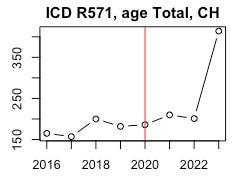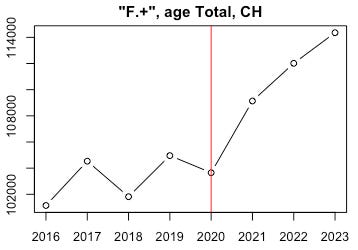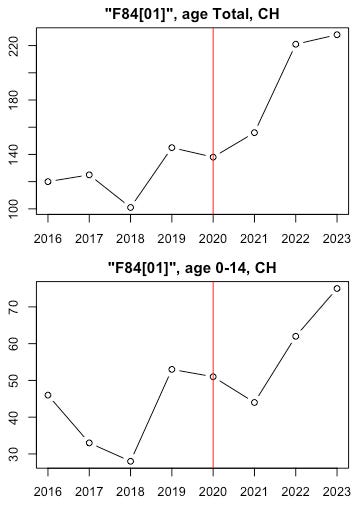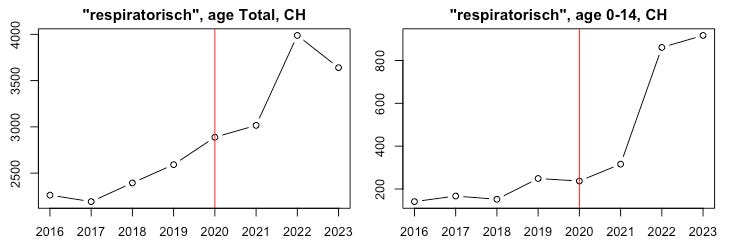Figures about ICD main diagnoses at hospital admission are yearly provided by the Swiss statistical office BMF. In an earlier article, I presented results up to 2022. Data up to 2023 are now available via email request.
I will largely refrain from medical interpretations. If you have any ideas, please feel free to write them in the comments.
General figures
The total amount of diagnoses continued to rise in 2023.
Fig. 1: Yearly number of hospital main diagnoses in Switzerland, 2016-2023. The red line marks 2020.
In order to identify flashy diagnoses, I filtered the data applying two criteria: at least 100 cases and an increase of at least 40% in 2023. I present the resulting diagrams without commentary (Fig. 2-9).
Fig. 2: ICD A400, Sepsis due to streptococcus, group A.
Fig. 3: ICD D143, Benign neoplasm of bronchus and lung.
Fig. 4: ICD E1120, Type 2 diabetes mellitus with kidney complications.
Fig. 5: ICD J9609, Respiratory failure.
Fig. 6: ICD L032, Cellulitis and acute lymphangitis of face and neck.
Fig. 7: ICD L040, Acute lymphadenitis of face, head and neck.
Fig. 8: ICD R570, Cardiogenic shock.
Fig. 9: ICD R571, Hypovolemic shock.
A search in the opposite sense, i.e. diagnoses that have fallen to 60% or less in 2023, did not generate any meaningful hits.
Mental and behavioral disorders
If we put aside physical suffering for a moment, the mental illnesses remain, which are marked with the letter "F" in the ICD classification. They continued to rise in 2023 as shown in Fig. 10.
Fig. 10: Letter “F”, Mental and behavioral disorders.
The increase in autism has slowed overall, but not among children (Fig. 11).
Fig. 11: ICD F84[01], Autism.
Depressions formed a cliff from 2020 to 2021 and remained high since then. Note the high numbers (Fig. 12).
Fig. 12: ICD F3[23], Depression.
Myocarditis, pericarditis, endocarditis
Inflammations of the heart muscle and its surrounding tissues (mycocarditis, endocarditis, pericarditis) remained high in 2023 (Fig. 13).
Fig. 13: Results from GREP query “karditis”, Inflammation of heart tissue.
Because it has been reported that this side effect of vaccines particularly affects young people, an age specific overview is given in Fig. 14.
Fig. 14: Inflammation of heart tissue in different age cohorts.
Especially among 15-39 year olds, these diseases seem to have increased noticeably since 2021. The number of cases has decreased in 2023, but is still elevated in comparison to pre-pandemic years.
Cancer
With regard to cancer, there was no clearly striking overall signal, apart from the continuous increase observed in many countries as a result of the ageing populations (Fig. 15).
Fig. 15: Diagnoses “C.*”, Cancer
Fever and cough
Fever lowered in 2023 after extremely high values in 2022. However, in most age cohorts, this common symptom remained on higher levels compared to pre pandemic years.
Fig. 16: GREP query “fieber", Fever.
For coughs, the picture looks quite similar.
Fig. 17: GREP query “husten", Cough.
Pneumonia and respiratory insufficiency
In the first article, I showed an increase in diagnoses in 2022 that affect infections, especially those of the respiratory system. This group of diagnoses decreased overall in 2023, but increased among 0-14 year olds. This is especially seen in the case of pneumonia (Fig. 18).
Fig. 18: Results from GREP query “pneumonie”, Pneumonia.
Pneumonia is probably associated with respiratory insufficiency, which also peaked in 2023 among 0-14 year olds (Fig. 19).
Fig. 19: GREP query “respiratorisch.*", diagnoses concerning the respiratory organs, mainly insufficiency.
Diseases of the musculoskeletal system and connective tissue
This diagnosis group provides huge numbers accompanied by a trend reversal in 2020 which continued up to 2023. However, the middle age cohorts are less affected (Fig. 20)
Fig. 20: GREP query “M.+” = Diseases of the musculoskeletal system and connective tissue.
“Muscle wasting and atrophy, not elsewhere classified” increased by more than a factor of 5 in 2022 and remained at a similarly high level in 2023. (Fig. 21).
Fig. 21: GREP query “M625.*”, Muscle wasting and atrophy, not elsewhere classified.
Injuries of the musculoskeletal system
Fractures of the Bones (feet to neck) were on an elevated level in 2022 and 2023. The age specific view reveals that exclusively the age cohort 70+ is affected by this, while the others are not (Fig. 22).
Fig. 22: GREP query “S[1-9][2]”, bone fractures (feet to neck).
If the code number “2” is replaced by “3”, we obtain dislocation, sprain and strain of joints and ligaments, and the result is quit the opposite: The young cohorts show very high levels, especially in 2023 (Fig. 23).
Fig. 23: GREP query “S[1-9][3]”, dislocation, sprain and strain of joints and ligaments (feet to neck).
Femur fraction and bone cancer?
I conclude my observations for 2023 with a highly consternating result. While analyzing, I noticed that an unusually high number of Swiss people broke a leg in 2023, namely their shaft of the femur.
Fig. 24: Fracture of shaft of femur
Although all age groups are involved, it appears most clearly among 0-14 year olds. Not only did a trend reversal occur from 2022 to 2023, the 2023 value also marks a record high. But what I find more disturbing is that malignant neoplasms of the long leg bones have also increased steeply among boys and girls. These bone cancers have approximately doubled in one year and the numbers are of a similar magnitude to the fractures (Fig. 25). Now the question arises wether there is a connection.
Fig. 25: GREP query “C402”, Malignant neoplasm of long bones of lower limb





























after my own considerations remain clearly significant AND associated to Covid measures/vaccinations:
-- "..karditis" age 15-39 , increase 2020 to 2021
nearly all Vaccinated of this age group got their first&2nd jab till fall 2021;
I assume that heavier cases of ...carditis show up very soon after shot. So most of the increase should be caused by Covid vaccinations. In the absent of vaccination there occured no significant increase in 2020, showing that not Covid for itself caused "..karditis".
-- "M625- muscle atrophy" age 40+and 70+
I assume delayed effect of lockdown and/or vaccination.
If only lockdowns would have been the main reason, in year 2021 there would have been
expected a greater increase already. As it happened in 2022 actually.
-- "Diseases of the musculoskeletal system" age groups 15-69 :
a strong trend of decrease from 2016 to 2020 is followed by a increase from 2021 onwards.
Turning point can easily be assumed as of somewhere earlier in the year 2021.
-- strong increase of "Pneumonia" from 2019 to 2020 should be due to Covid infections and/or more sensitivity especially of respiratory llness suffering patients leading to more health care system visits and in consequence more diagnoses. But I guess more of the first cause.
-- increase of "Cough" als solely diagnosis is statisitically relevant, but in absolute numbers and from point of severity of illness not very important.
--LD032 / LD040 with clear significant increase from 2022 on,
similar to increase of
-- R570 /R571 , but both from 2023 on!
CANCER:
I see very high probability of increase 2022 at age 0-14 caused by vaccinations given to children from late 2021 onwards! --- very bad and sad.
from midth of 2022 onwards there were nearly no more jabs administered to children, so numbers of new cancer in children decreased in 2023.
Notably
age group 40-69 shows even in 2023 a lower cancer level as in prepandemic years!
maybe due to less visitations of health care system as established in general since start of pandemic, leading to less diagnosis?
maybe due to excess mortality concerning especially high vulnerable persons since 2020, that took away some first candidates for cancer, which therefor didnt became statistically ?
Thank you very much, excellent analysis!
I think your analyses stress the importance to look not only at totals but also at different age classes; although this is tricky due to multiplicity problems.
The look at different age classes appears particularly important for “carditis”: Overall there was no clear trend, rather a continuation of a long-term increase. However, the age classes 0-14 and in particular 15-39 showed the issues that we C19 critics were afraid of for long. In contrast, the 70+ showed a long-term rise, maybe also the 40-69. Hence, there might be two deleterious factors: The C19 vaccines, evident in the younger, and cardiovascular medication (in general) in the elderly. For the latter I would think of antihypertensive medication, but we should also not forget statines and ezetemib, but maybe also recent antidiabetics. All these medications are virtually not given to those below 14, and rarely to those below 40, but to most above 70. Lumped together, we can no more or hardly identify the effect of the C19 vaccines on carditis on whole population level.
We should keep this in mind when interpreting the other figures and diagnoses. There might be a similar effect in cancer diagnoses. There is a plethora of data indicating that biopsies may trigger cancer or its spread. Biopsies are increasing with age; and nowadays also in woman in younger ages.
Striking are the figures for fever. This is the most typical sign (to be understood as in between signs and symptoms) for flu-like illness. It was certainly a very frequent immediate reaction of these vaccines. However, in 2022 these vaccines were far less frequently administered. Moreover, most data quite consistently indicate that booster (given since late 2021) caused less immediate reactions. This means that the sharp increases observed in 2022 are hardly to be interpreted as immediate reactions, but rather as long-term reactions to them, most likely as anyhow impairing infection defence. This assumption is further supported by the increases in coughing (“Husten”), pneumonia, and respiratory problems.
The effect of impaired infection defence should also be considered when interpreting increases in the various forms of “-itis” as well as cancer.
A bit surprising to me are the increases in “M” and in particularly in M625 (muscle wasting and atrophy). The latter most likely reflect the cases of “post vax”, which the mainstream prefers to label as “Long Covid”. Maybe other M diagnoses are related to this, but were less correctly differentiated. In turn, injuries to the musculoskeletal system might reflect the M- and M625-problems, but also the fractions, although they might also be explained by falls which were typically seen within the first 2 weeks of a vaccination.